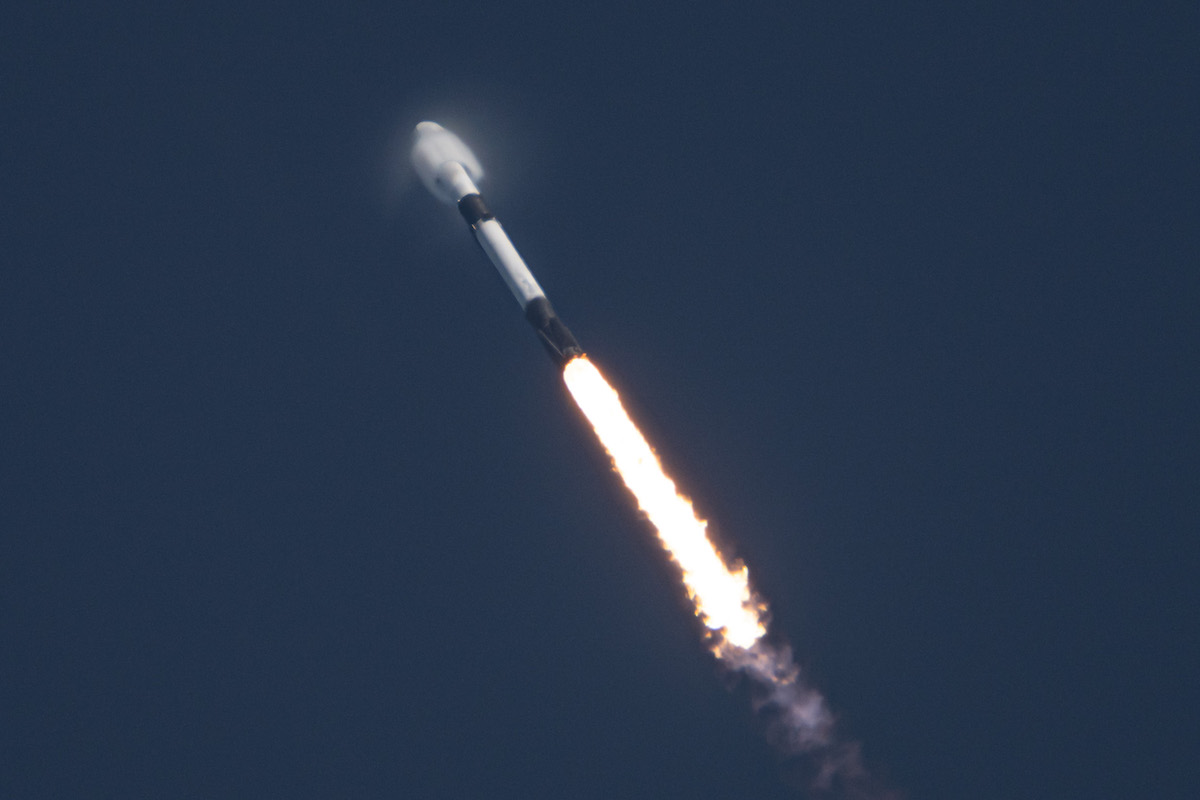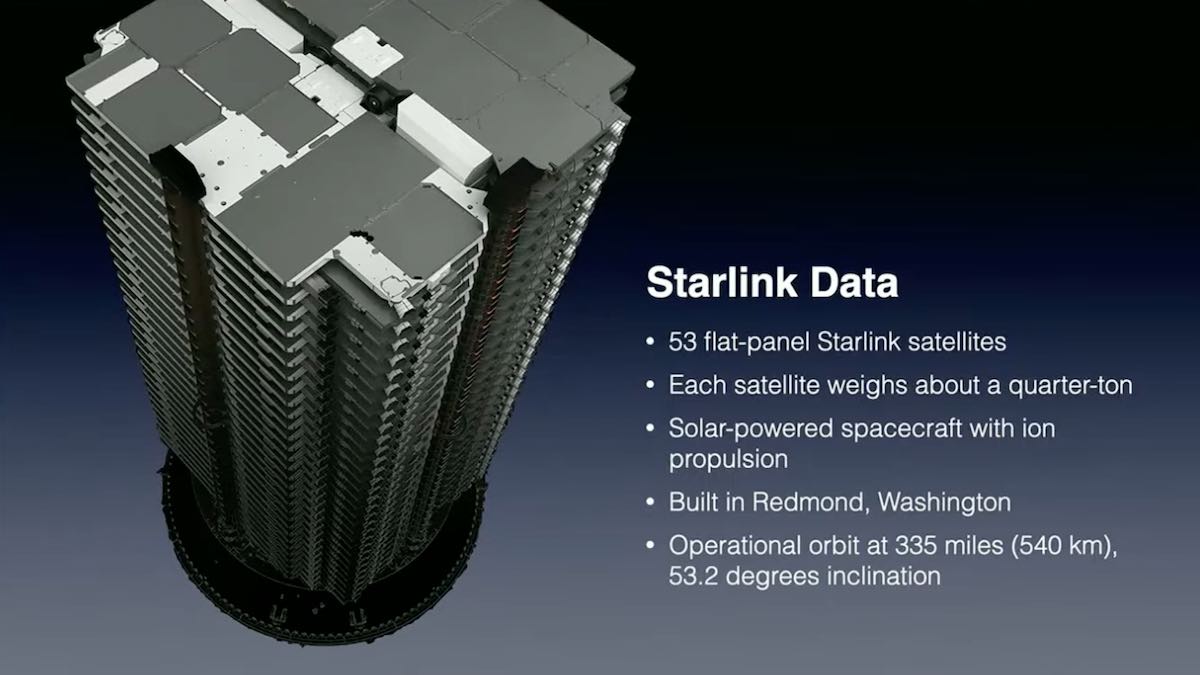
Fifty-three new Starlink internet satellites launched Friday from Cape Canaveral aboard a Falcon 9 rocket, adding more capacity to the largest fleet of spacecraft ever put into orbit.
The 229-foot-tall (70-meter) Falcon 9 rocket took off from pad 40 at Cape Canaveral Space Force Station at 3:21:20 p.m. EDT (1921:20 GMT). Nine Merlin 1D engines powered the rocket off the pad with 1.7 million pounds of thrust, hauling more than 15 metric tons of payload into space.
Each of the 53 satellites weighed about 650 pounds (295 kilograms), and were flat-packed to fit inside the Falcon 9 rocket’s nose cone for liftoff Friday. The mission, designated Starlink 4-27, was the 56th Falcon 9 launch primarily dedicated to deploying satellites for the Starlink network.
The launch was the 37th Falcon 9 flight of the year, and the 171st launch of a Falcon 9 rocket since its debut on June 4, 2010. It was the 146th consecutive successful mission by a Falcon 9 or Falcon Heavy rocket since the explosion of a Falcon 9 and the destruction of its commercial satellite payload during a pre-launch test in 2016.
Liftoff of SpaceX’s Falcon 9 rocket from Cape Canaveral carrying 53 more Starlink internet satellites into orbit. https://t.co/IKKOFB1Kc7 pic.twitter.com/lm4MbRIKUV
— Spaceflight Now (@SpaceflightNow) August 19, 2022
The Falcon 9 rocket headed northeast from Cape Canaveral after liftoff from pad 40. The first stage fired for two-and-a-half minutes before detaching to begin a descent toward SpaceX’s drone ship “A Shortfall of Gravitas” in the Atlantic Ocean about 400 miles (650 kilometers) downrange from the launch site.
The first stage booster used cold gas thrusters to re-orient itself to a tail-first attitude, and extended four titanium grid fins to help guide the rocket during its hypersonic re-entry into the atmosphere.
Meanwhile, the Falcon 9’s upper stage burned for about six minutes to place the Starlink satellites into a transfer orbit ranging between 144 miles and 208 miles (232-by-336 kilometers), at an inclination of 53.2 degrees to the equator.
The first stage for Friday’s launch is designated B1062 in SpaceX’s inventory. The booster’s first launch was on Nov. 5, 2020, with a U.S. military GPS navigation satellite. Since then, the rocket has now launched two commercial astronaut missions, another GPS satellite, the Egyptian Nilesat 301 communications spacecraft, and four Starlink missions.
SpaceX’s reusable first stage booster has landed on a drone ship in the Atlantic Ocean. This was the ninth trip to space for this booster after launching 53 more Starlink satellites from Cape Canaveral. https://t.co/IKKOFB1Kc7 pic.twitter.com/szNGYzZjkx
— Spaceflight Now (@SpaceflightNow) August 19, 2022
The Falcon 9’s reusable payload fairing also jettisoned during the second stage burn. A recovery ship was on station in the Atlantic to retrieve the two halves of the nose cone after they splashed down under parachutes.
The upper stage of the Falcon 9 deployed the 53 Starlink satellites at T+plus 15 minutes, 15 seconds. The Starlink satellites separated from the Falcon 9’s upper stage after it released four retention rods that held the spacecraft to the rocket during launch.
The satellites will deploy their power-generating solar arrays and use ion engines to climb to an altitude of 335 miles (540 kilometers). The orbit-raising maneuvers typically take a few weeks to a few months, depending on the orbital plane targeted for each spacecraft.

SpaceX has now launched 3,108 Starlink satellites after Friday’s mission, including prototypes and earlier spacecraft designs no longer in service.
A tabulation by Jonathan McDowell, an astrophysicist and expert tracker of spaceflight activities, shows there are 2,809 Starlink satellites functional in orbit, as of Friday. The network has 2,313 satellites operational providing consumer broadband services, and the rest are maneuvering into the final orbital positions, according to McDowell.
SpaceX has two more Starlink missions scheduled before the end of August. One of them will take off from Launch Complex 39A at NASA’s Kennedy Space Center in Florida, and another will depart from Vandenberg Space Force Base in California.

The Starlink launch from Florida is scheduled for next Saturday, Aug. 27. The preliminary launch time for that mission is 10:22 p.m. EDT (0222 GMT on Aug. 28), less than 36 hours before NASA plans to launch its huge Space Launch System moon rocket from pad 39B at Kennedy.
A launch date for the Vandenberg mission has not been confirmed.
The Starlink satellites are built on SpaceX’s Starlink assembly line in Redmond, Washington. The spacecraft are fitted with laser inter-satellite links to facilitate data transfers in orbit, without needing to relay signals through ground stations, which come with geographical, and sometimes political, constraints. Laser crosslinks can also reduce latency in the Starlink network because signals need to travel a shorter distance.
The photo below as captured through a telescope from London, showing the 53 Starlink satellites and the Falcon 9’s upper stage in space about seven minutes after payload separation.
Starlink 4-27 satellites + Falcon-9 second stage
7 minutes after deployment / 22 minutes after launch
It was an awesome sight! 😊@FelixSchlang @John_Winkopp @planet4589 @Marco_Langbroek @DJSnM @Grandpajoe42 @skyatnightmag @SPACEdotcom @Teslarati @SpaceflightNow pic.twitter.com/czwbsZLm4w— Space Station Guys (@spacestationguy) August 19, 2022
Email the author.
Follow Stephen Clark on Twitter: @StephenClark1.
